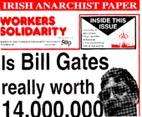Over 30 years of anarchist writing from Ireland listed under hundreds of topics
The Militias in the Spanish Revolution - review of The Spanish Civil War by Antony Beevan
A SURPRISING BEST SELLER last year was 'Stalingrad' by the same author. His publishers have obviously re-released this book, first published in 1982, to cash in on this. As you might expect, it is primarily a military history of the Spanish Revolution. But it is a very welcome break from the normal pattern of mainstream military histories of the Spanish Revolution. For the most part these fail to discuss the revolution within the civil war, the thousands of collectives or the role of the anarchists. If they are mentioned, they are usually portrayed as an obstruction to the efficient military pursuit of the war by the republican side.
Beevan's approach is fresh and different. He understands that much of what made the Spanish Civil War unique from a military viewpoint was the revolution that had taken place. Rather than ignoring the anarchists or treating them as a minor nuisance he puts them where they belong, at the heart of the story. So the opening third of the book concentrates on the politics of Spain, both before and in the first months of the war. Beevan shows a surprising understanding of anarchism, indeed his explanation of anarchism contains little I could disagree with and extends well beyond Spain, quoting the Italian revolutionary Errico Malatesta and referencing the Ukrainian Makhnovists.
Early days
His discussion of the first days of the revolution, the formation of the militias and the role they played is excellent. He correctly attributes the defeat of Franco in half of Spain as due to the actions of the workers' organisations and, in particular, the anarchist CNT. While the government pleaded with the rebel generals and refused to release arms to the workers, the CNT broke into gun shops, raided armouries and then fought and defeated the army. He points out that in the areas where Franco's forces seized power they did so precisely because the local workers' organisations trusted the local government to control the army or were unable or unwilling to seize weapons.
In the space of a short review there is no room for discussing all the key areas in this book but worth mentioning is his discussion of the militias and the conventional army. While making the usual criticism of the militias for lack of discipline, he points out that this was inevitable in their rapid formation and was something the anarchists sought to address. They were capable of heroic and disciplined fighting, for instance at Irun where, with their backs to the border, they fought the fascist advance house by house until they ran out of ammunition. The last two major conventional battles of the war were both fought by anarchist regiments in the regular army.
As he points out, the Spanish Communist Party used the fact that Russia was the only major supplier of weapons to the Republic to deny the anarchist militias arms. The book really comes into its strength here, as the military account of the war shows the impossibility of mounting offensive operations with severely limited supplies against a well dug in and trained enemy, which enjoyed massive superiority in artillery and air power.
He discusses the regular army and the International Brigade. The Communist Party was able to dominate these and here we see similar methods of command to those used by Trotsky in the Russian Civil War. The major emphasis was on blind obedience to orders, with frequent executions of those who resisted. Apparently up to 10% of some International Brigade units were executed. But beyond this, he also highlights the complete failure of the offensives mounted by the regular army.
Lions led by donkeys?
It is this section that is perhaps most interesting. The strategy of the Communist dominated army was for conventional mass assaults in which the best units and equipment were concentrated against a relatively short section of the fascist line. These rapidly ground to a halt as Franco was able to concentrate huge quantities of artillery and airpower against them. But because they were prestige operations for the Communist Party the offensive was continued, often involving suicidal frontal assaults like those of WWI in which huge quantities of men and equipment were sacrificed for a few yards with no real strategic value.
There is much else in this book of value to anarchists, in particular his revelations of how the British government actually aided Franco. He also outlines an alternative strategy for fighting the war, based on using conventional military methods for defence but attacking with large scale guerrilla offensives. He also discusses the role of Spanish republicans in the French resistance during WWII and the guerrilla warfare conducted against Franco into the 1960's. This is a book well worth buying!
Cassell Military Paperbacks. stg£6.99


